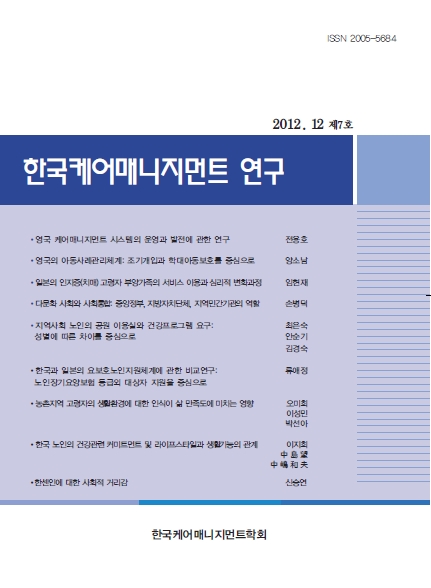구조방정식모형을 이용한 한국어판 Short-Form 36 Health Survey (SF-36) 척도의 구성타당도 검증
Use of Structural Equation Modeling to Test Construct Validity of the SF-36 Health Survey among Community-dwelling Elderly in Korea
- 한국통합사례관리학회
- 한국케어매니지먼트 연구
- 제4호
-
2009.1245 - 59 (15 pages)
- 1,167

본 연구는 구조방정식모형(structural equation modeling)을 이용하여 건강관련 삶의 질 척도인Short-Form 36-Item Health Survey (SF-36)의 구성타당도를 검증하고자 하였다. 조사대상자는 지역사회 거주노인 1,636명으로, 일대일 면접 설문조사를 통해 노인의 건강관련 삶의 질(SF-36)과 연령, 성별 등에 대한 자료를 수집하였다. SF-36의 구성타당도를 알아보기 위해 구조방정식모형을 이용하여 확인적 요인분석(Confirmatory factor analysis)을 실시하였다. 연구 결과는 기존의 여덟 개의 일차 요인 모델의 우수성을 확인할 수 있었으나, 고차 분석 결과에서는 상관된 세 개의 이차 요인과 일 삼차 요인이 데이터에 적합한 것으로 나타났다. 이러한 검증결과는 SF-36가 다차원 구조를 가지고 있으며, 한국의 지역거주 노인들을 대상으로 본 척도를 사용할 때에는 모든 문항의 요약된 합계점수를 사용하는 것 보다 여덟 개의 하위 점수를 사용하는 것이 보다 바람직하다는 것을 시사한다.
This study was done to evaluate construct validity of the Short-Form 36-Item Health Survey (SF-36) in a sample of Korean community-dwelling elderly, using structural equation modeling (SEM). Data were collected from 1,636 participants in a stratified sample of community-dwelling elderly in Korea, interviewed face-to-face by trained interviewers. The subjects completed individual characteristics (sex, age, with or without stroke), the MOS Short-Form 36-Item Health Survey (SF-36), and the Barthel Index (BI). The construct validity of the SF-36 survey was assessed using Structural Equation Modeling (confirmatory factor analysis) through an evaluation of the original eight-factor structure: Physical Functioning (PF), Role Physical (RP), Bodily Pain (BP), General Health (GH), Vitality (VT), Social Functioning (SF), Role Emotional (RE), and Mental Health (MH). Structural equation modeling (SEM) analyses supported the superiority of the eight first-order factor model of health. Higher-order analyses suggested that a model with three correlated second-order factors (physical health- PF, RP, BP, general well-being- GH, VT; and general mental health- SF, RE, MH) and one third-order factor (health) provided a satisfactory fit to the data. These results confirm the multidimensional structure of the SF-36 suevey and underscore the feasibility of multinational comparisons of health status using this instrument. They also support the use of eight subscale scores in parallel with two second-order summary scores rather than one overall score.
요약
Ⅰ. 서론
Ⅱ. 연구방법
Ⅲ. 결과
Ⅳ. 고찰
참고문헌
Abstract
(0)
(0)